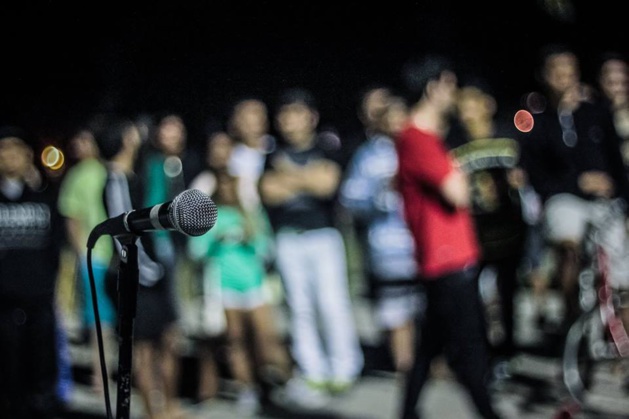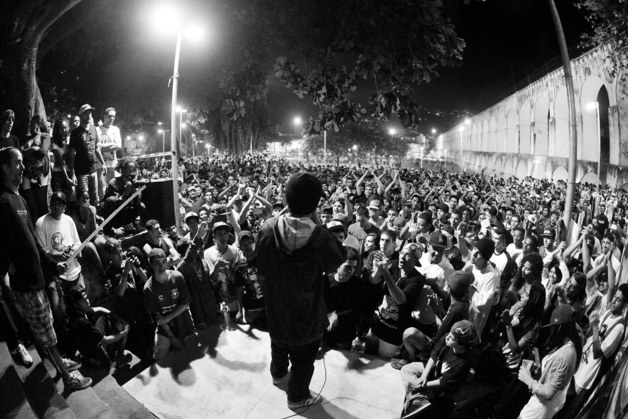
Credit RR
The Carioca Circuit of Rhythm and Poetry, or CCRP, is a completely independent movement, born of civilian initiative: A youth which, through lacking means or structure, has taken the path of artistic expression. It was in 2010, following a successful first event in the district of Botafogo, that other urbane cultural encounters have progressively spilled across the city. This is the year that CCRP formed. It was then possible to better organize such events and improve their diffusion on the Internet, most notably through social networks. Open scene and rap battles are at the heart of these meetings organized by the collective.
The aforementioned collective has invoked not only the expansion of this culture of rhyme and improvisation, but also of the urbane culture in its ensemble: graffiti, visual art, skating and dance, with a specialty for each area. Entry is free. The objective is to democratize access to culture, to bring it where it is least present or completely absent, and this through the occupation of public spaces. Farani, in Botafogo, is a result of this effort. Once a hub for the consumption of hard drugs, the atmosphere has changed radically after being the setting of the famous roda de rima.
The space has since become a place of artistic divulgation and of socialization. The extremely active network, gathers in between 5000 and 8000 youths each week from the ensemble of 8 districts, including Bangu, currently suspended due to militia, Manguinhos on Mondays, Botafogo on Tuesdays, Freguesia and Méier on Wednesdays, Vila Isabel and Recreio on Thursdays, and Lapa on Saturdays. The phenomenon of these rodas culturais has taken a yet greater extent: 60 different areas have opened their doors to these cultural manifestations across the entire State of Rio di Janeiro, most notably the cities of Macacé, Teresopolis, and Petropolis.
Last November, on the fourth anniversary of the collective, the CCRP organized in the district of Lapa, a festival celebrating the culture of rhythm and rhyme, but also of the circus, film, craftsmanship, and art in general. Entry was free. The objectives of this event were to contribute to the spread of local urbane culture, to democratize access to cultural goods and services and to promote reading and writing.

Professional Opportunities
Beyond their playful aspect, these events offer participants the chance to create for themselves professional network: it creates the moment where musician meets producer, or graphic artist meets art gallery director; in summation, it is a place for the reunion of independent workers. The work of CCRP has been equally instrumental in discovering unknown young talents, and also evolving the careers of certain artists while lacking means or connections in the music industry.
A desire for diversity
The idea of these events is to implant the whole of urbane culture, not only rap, in the cultural landscape of Rio de Janeiro. But it acts also to insert Brazilian culture into this musical discipline. There exists a will to distinguish itself from the stereotype of North American hip-hop, where women are often presented as sexual objects. Djoser Botelho Braz, a cultural producer, member and founder of CCRP, recalls that rhyme and improvisation have been present for a long time in Brazilian music, most notably in samba, and that they are not reserved for their American neighbors. This originality constructs itself in turning to instruments and rhythms issued by traditional national music.
Relation with the public powers
In 2012, two years after the creation of CCRP and faced with the undeniable extent of this urban phenomenon, City Hall has decided to open discussions with the collective. The mayor of Rio de Janeiro, Eduardo Paes, has taken interest in what has happened in the city streets and has summoned the members of CCRP. They have presented to him their project: it pleased the mayor, who signed the development of rhythm and carioca poetry or pacto do rap, and a decree officially recognizing the CCRP, stipulating financial and structural support.
However, it was only a year afterwards before the creation of Eixo Rio, an intermediary institute between public powers and urban culture. Renato Rangel, one of its members, explains his role as mediator around the theme of the occupation of public space and of living together: “There is work towards articulation between what artists and spectators need, and what the public powers can do to facilitate access to those things. This dialogue has to let the participants of these events understand that there are a certain number of rules, most notably schedules, which they must respect so that the city hall can grant access to these public places. There are concessions to make to satisfy everybody, namely the residents of the area. The idea is to allow the Carioca, habitants of Rio, to profit from the public space, to develop it and recognize themselves, all with respect for others. Today, Rio de Janeiro reconnects with its cultural vocation in the streets.” Finally, while this dialogue has allowed the reduction of repression that CCRP has made their goal with their events, no financial support from public powers have been put into place for the time being.
“Any revolution, today, is made through art. I often tell my friends that a camera is a weapon, that the development of the imagination is something we have to work towards every day, because it’s thanks to art that we can change our reality.” Djoser, member of the CCRP





























